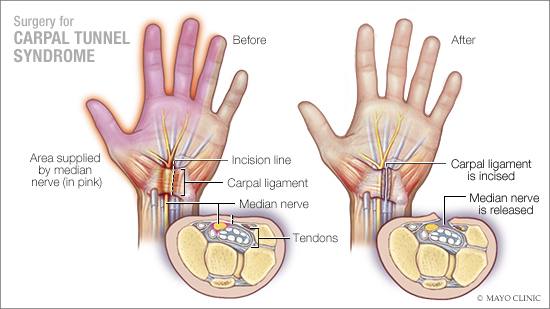carpal-tunnel-release-surgery
Carpal tunnel syndrome is a condition that causes numbness, tingling, and other symptoms in the hand and arm. Carpal tunnel syndrome is caused by a compressed nerve in the carpal tunnel, a narrow passageway on the palm side of your wrist.
The anatomy of your wrist, health problems and possibly repetitive hand motions can contribute to carpal tunnel syndrome. Proper treatment usually relieves the tingling and numbness and restores wrist and hand function.
Symptoms
Carpal tunnel syndrome symptoms usually start gradually. The first symptoms often include numbness or tingling in your thumb, index and middle fingers that comes and goes. Carpal tunnel syndrome may also cause discomfort in your wrist and the palm of your hand. Common carpal tunnel syndrome symptoms include:
✔ Tingling or numbness:
You may experience tingling and numbness in your fingers or hand. Usually the thumb and index, middle or ring fingers are affected, but not your little finger. Sometimes there is a sensation like an electric shock in these fingers. The sensation may travel from your wrist up your arm. These symptoms often occur while holding a steering wheel, phone or newspaper. The sensation may wake you from sleep. Many people “shake out” their hands to try to relieve their symptoms. The numb feeling may become constant over time.
✔ Weakness:
You may experience weakness in your hand and a tendency to drop objects. This may be due to the numbness in your hand or weakness of the thumb’s pinching muscles, which are also controlled by the median nerve.
Causes :
Carpal tunnel syndrome is caused by pressure on the median nerve.
The median nerve runs from your forearm through a passageway in your wrist (carpal tunnel) to your hand. It provides sensation to the palm side of your thumb and fingers, except the little finger. It also provides nerve signals to move the muscles around the base of your thumb (motor function).
Anything that squeezes or irritates the median nerve in the carpal tunnel space may lead to carpal tunnel syndrome. A wrist fracture can narrow the carpal tunnel and irritate the nerve, as can the swelling and inflammation resulting from rheumatoid arthritis. There is no single cause in many cases. It may be that a combination of risk factors contributes to the development of the condition.
Surgery of the carpal tunnel aims to release pressure by removing tissue that is pressing on the nerve. The results of the surgery will depend in part on how long the condition has existed and how much damage has been done to the nerve. For that reason it is a good idea to see a Specialist Plastic Surgeon early if you think you may have carpal tunnel syndrome.

